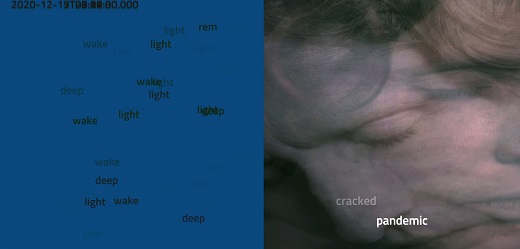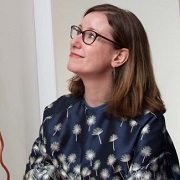
Following on from a wide-ranging panel discussion on the impact and implications of COVID-19 and the changing nature of time when Professor W.J.T. Mitchell was a Visiting Scholar at NUI Galway in 2021, Nessa Cronin continues this discussion with a short piece that was recently published for the ‘In the Moment’ Blog of the journal Critical Inquiry. Many thanks to scholar and visual artist Dr EL Putnam for permission to discuss and reproduce an image of her work again here
The panel discussion, hosted by the Moore Institute, is also available to view here, and later published as, “Present Tense 2020: On the Iconology of the Epoch,” Critical Inquiry 47 (Winter 2021), pp. 370-406.
Threshold Times: From the “No Longer” to the “Not Yet”
“It’s a curse to live in interesting times,” so goes the ancient Chinese proverb that Hannah Arendt was known to cite in the last years of her life.[1] In her essay “No Longer and Not Yet,” Arendt observes that sometimes dramatic moments occurring in human history are experienced more as a real rupture heralding a new era, rather than the gradual unfolding of the old. The decline of the old and the birth of the new, she writes, “is not necessarily an affair of continuity” as “between the generations, between those who for some reason or other still belong to the old and those who either feel the catastrophe in their very bones or have already grown up with it, the chain is broken and an ‘empty space,’ a kind of historical no man’s land, comes to the surface which can be described only in terms of ‘no longer and not yet.’”[2]
For many of us living through these pandemic times we seem to be living in such an “empty space” in a collective caesura of an indistinct “now” caught between pre- and post-COVID-19 worlds, stuck in an “historical no man’s land” that has somehow continued in calendar time but has not yet quite fully moved on to the future, whatever that may be. Since the arrival of COVID-19 there has been a feeling that life before the pandemic seemed to belong to another time and epoch. W. J. T. Mitchell has noted how “the year 2019 now seems to belong to another century”.[3] The past is indeed another country. While the present may seem to be of a different time and order, one gets the distinct feeling that we have not yet fully come to terms with the suspended space of our “now”.
After the first wave of the pandemic in Europe Turkish novelist Elif Shafak wrote of “the world to come,” and argued that “This is a threshold. The old world is simply no more. . . . The old world is gone, and yet we do not know what kind of a new world we want to build. It is a state of in-between-dom, full of anxiety and uncertainty, and fertile ground for demagogues and their false promises of redemption.”[4] Stuck between calendar time in “real life” and an atemporal experience of the “virtual,” the frozen zoom screen seems to be the best visual representation and haptic experience of the pandemic “now”, signifying a moment in which time is seen to jump, skip, crack and freeze, through different spaces and time zones and sometimes, confusingly, happening all at once as seen in the work of digital artist and philosopher EL Putnam.[5] Screens now act as third parties in relationships, and often as a third party mediating between our “real” and “virtual” selves. As Jedediah Britton-Purdy has noted, we are now an “infrastructure species,” a category he uses to describe our physical and technological relationship to the world we have created.[6]
The compression chambers of climate change and COVID-19 makes this contemporary period an “event” in itself. What has become increasingly visible throughout the pandemic is how language and rhetoric associated with the 2008 global financial crisis has re-appeared as an individualizing resilience narrative. Neoliberal narratives of “personal responsibility” foreground the primacy of the individual rather than the responsibility of the state in protecting the public and environmental health of its citizens.
Such narratives also demonstrate an apparently willful lack of understanding of epidemic or other crisis events and can even go further by viewing such events as opportunities in the Malthussian sense (“no more fucking lockdowns – let the bodies pile high in their thousands”[7]), echoing the narratives of disaster capitalism as previously observed by Naomi Klein post-2008.[8]
More troublingly, however, is that the mantra of “personal responsibility” singularly assumes a level playing pitch for all members of society, with the concept concealing a dangerous assumption that everyone has the same level of social supports and economic security to help cushion them in a time of crisis. Not everyone can exercise personal responsibility by not exposing themselves to the virus when commuting to work on public transport, shielding a close relative, teaching or caring for unvaccinated children, or working in a meat-packing plant. Indeed, the mandates to work from home blithely assumed that everyone has an adequate home-space to work/learn from. Such narratives assume that “home” is a safe space and sanctuary from the viral dangers in the public sphere, instead of being a private space of harm for many in what has been regarded as a shadow pandemic of domestic violence.[9]
The assumptions behind the the phrase “personal responsibility” are therefore highly gendered, class-based, and politically structurally-biased; they make already inequitable social systems even more dangerous for many. These are just some examples of a highly problematic resilience narrative that has gained traction without sustained critique, and will undoubtedly re-emerge in future times. The failure to protect yourself and your loved ones, so the narrative goes, implies a moral failing on your part to “assess the risk” and act with “personal responsibility” to swerve and dodge that COVID-19 or climate wave coming your way.
We have much to learn from the necropolitics of the present in terms of how such resilience narratives will shape future crisis scenarios, therefore such narratives should be carefully tracked and forensically examined for what they ideologically assume and, conversely, what they dangerously conceal. Caught between the vice grips of the biopolitical crisis of the virus and the existential crises of climate change, we are living in a threshold decade, a pivotal time when decisions made now will set in train biopolitical tipping points that will determine the future of life to come, for better or for worse.
______________________________________________
[1] Quoted in Jerome Kohn, “Introduction” to Hannah Arendt, Essays in Understanding, 1930-1954: Formation, Exile, and Totalitarianism (New York, 1994), p. ix.
[2] Hannah Arendt, “No Longer and Not Yet,” p. 158.
[3] W. J. T. Mitchell, “Present Tense 2020: On the Iconology of the Epoch,” Moore Institute Webinar, 9 June 2021, National University of Ireland, Galway https://www.youtube.com/watch?v=-WFCen3FmbE, later published as, “Present Tense 2020: On the Iconology of the Epoch,” Critical Inquiry 47 (Winter 2021), pp. 370-406. I am very grateful to Professor Mitchell for discussions on this theme when I presented at this webinar as a panelist respondent to his paper, much of which gave rise to the considerations expressed here.
[4] Elif Shafak, “The World to Come,” New Statesman, 20 August 2020. https://www.newstatesman.com/uncategorized/2020/08/world-come-old-world-gone Also see, Elif Shafak, How to Stay Sane in an Age of Division (2020).
[5] See http://www.elputnam.com/
[6] Jedediah Britton-Purdy, This Land is Our Land: The Struggle for the New Commonwealth (Princeton, New Jersey, 2019).
[7] Prime Minister of Britain Boris Johnson was allegedly to have said this rather than impose further restrictions or lockdowns in Britain at the height of the wave. See, Jessica Elgot and Robert Booth, “Pressure mounts on Johnson on alleged ‘let the bodies pile high’ remarks,” The Guardian, 26 Apr. 2021, https://www.theguardian.com/politics/2021/apr/26/pressure-mounts-on-boris-johnson-over-alleged-let-the-bodies-pile-high-remarks
[8] Initial media reporting of the COVID-19 crisis in Britain made reference to the tenor of conversations in government circles in relation to the impact of the virus on the elderly population in particular and a policy of herd immunity: “The report claimed that at one private event at the end of February, Cummings outlined then government’s strategy at the time in a way that was summarised by some present as “herd immunity, protect the economy, and if that means some pensioners die, too bad.” https://www.theguardian.com/politics/2020/mar/22/no-10-denies-claim-dominic-cummings-argued-to-let-old-people-die And that the excess deaths of 125,000 people in the UK by March 2021 means that the Treasury will save more than £1.5 billion in state pension payments in 2022. https://www.theguardian.com/commentisfree/2021/mar/12/covid-crisis-social-care-elderly-people On Naomi Klein see, The Shock Doctrine (2008)
[9] I’m making the distinction here between home environments and living quarters to highlight the particular challenges that men, women and children who live in asylum and detention centers encountered during successive periods of lockdown in Ireland (known as Direct Provision Centers) and Europe more widely.


